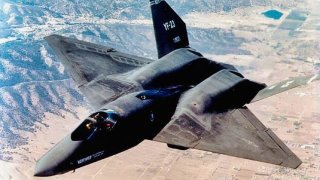The YF-23 Fighter Might Have Suffered the Same, Sad Fate as the F-22 Raptor
Speculations about what the YF-23 could have achieved in service remain a captivating "what if" scenario, with its legacy untarnished by the realities of operational challenges, technological obsolescence, or financial criticisms that have befallen the F-22. This narrative cements the YF-23's place in aviation lore, a beautiful relic of aerospace ambition unblemished by the trials of time and service.
Summary: Speculations about what the YF-23 could have achieved in service remain a captivating "what if" scenario, with its legacy untarnished by the realities of operational challenges, technological obsolescence, or financial criticisms that have befallen the F-22. This narrative cements the YF-23's place in aviation lore, a beautiful relic of aerospace ambition unblemished by the trials of time and service.
YF-23 Fighter: The Big What-If Stealth Fighter
The Northrop Grumman YF-23 is perhaps the most revered aircraft never produced.
Only two YF-23s were ever made. The aircraft was Northrop’s bid for the U.S. Air Force’s Advanced Tactical Fighter program, or ATF. The jet has lodged itself in the aviation community’s collective consciousness as a What Could Have Been. But like a rockstar who died young, the YF-23 was spared from the production and service history that often invites criticism, preserving instead the idealized memory left by the prototypes.
YF-23: Answering the Call
As the Cold War climaxed in the 1980s, the U.S. was engaged in an arms race with a hollowed-out Soviet Union. Despite having recently fielded fourth-generation fighters like the F-14, F-15, F-16, and F/A-18, the U.S. was eager to outpace any fear the Soviets might catch up and produce a peer aircraft.
The result – the active effort to develop a fifth-generation fighter before the Soviets – was the ATF program.
Two aerospace corporations answered the ATF call: Lockheed Martin and Northrop Grumman. Lockheed offered the YF-22, which would win the bid and become the F-22 Raptor. Northrop Grumman’s losing bid, the YF-23, has earned a cult-like following in the aviation community, leaving many to ask whether the YF-23 would have been a more capable production model than the F-22.
The F-22 has a 30-year history to assess and criticize. In many respects, the aircraft is an outstanding success as the world’s first fifth-generation fighter. Indeed, it is the world’s most capable air superiority fighter even today. But the F-22 has its drawbacks – namely, the cost per unit, vulnerability to small arms fire, and its already outdated stealth technology.
Had the YF-23 won the ATF contract and entered full-scale production, we would have 30 years of history and performance to serve as a base of criticism for this aircraft, rather than its competitor. It would be three decades old, no longer representing the latest technology. The U.S. would have sunk billions of dollars into the YF-23 program, increasing critical sensitivity to the jet’s performance.
The YF-23 is like John F. Kennedy, Kurt Cobain, or James Dean – it died early and was beatified as a result. But the benefit of dying young, at least as far as public perception is concerned, is that a special emphasis is placed on your existing accomplishments. The void of your absence is filled with nostalgic projections of what could have been. But what if JFK’s second term had been counterproductive? What if he had failed to make progress on Civil Rights, or if he had been the one to really escalate the war in Vietnam? What if Nirvana’s fourth album, or Dean’s next movie, had been dreadful?

The point of course is that we don’t know what would have happened had the YF-23 had been produced over the YF-22, and in all likelihood the results would have been a mixed bag. For example, the F-22 was cut after just 187 planes due to costs. The YF-23 could have suffered the same, sad fate.
One thing is certain, however: An F-23 in USAF livery would have been a gorgeous aircraft.
Harrison Kass is a defense and national security writer with over 1,000 total pieces on issues involving global affairs. An attorney, pilot, guitarist, and minor pro hockey player, Harrison joined the US Air Force as a Pilot Trainee but was medically discharged. Harrison holds a BA from Lake Forest College, a JD from the University of Oregon, and an MA from New York University. Harrison listens to Dokken.


